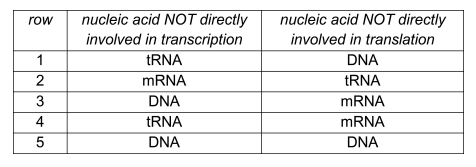Which row correctly identifies a nucleic acid NOT directly involved in transcription, and a nucleic acid which is NOT directly involved in translation?

A. row 3
B. row 5
C. row 1
D. row 4
E. row 2
Which row correctly identifies a nucleic acid NOT directly involved in transcription, and a nucleic acid which is NOT directly involved in translation?

A. row 3
B. row 5
C. row 1
D. row 4
E. row 2
The correct answer is C.
What is DNA transcription ? DNA to RNA
DNA transcription is the process that allows the formation of a single complementary strand of mRNA, based on the DNA structure.
It takes place in the nucleus and its byproducts, the mRNA strands, will be made into functional proteins in the cytoplasm through the process of translation.
It involves :
mRNA is made up of a single-stranded molecule of RNA. It is relatively short (~2kb) and made up of four nucleotides : adenine, uracil, guanine and cytosine. Thymine is demethylated and replaced by uracil in RNA strands.
Transcription is a process that can be divided into 3 steps : initiation, elongation and termination. In simple words :
tRNA is NOT involved directly in transcription.
What is translation ? RNA to protein
Once the mRNA is released, it goes out of the nucleus. That is when the ribosomes and tRNA come into play.
tRNA serves as the adaptor between the messenger RNA and the chain of amino-acids that is being synthesized. In other words, it carries the amino-acids into the ribosome to enable protein synthesis.
It contains an anticodon, which is made of 3 nucleotides, and serves to ensure proper protein synthesis. The anticodon is complementary to the mRNA strand.*
DNA is NOT directly involved in translation.